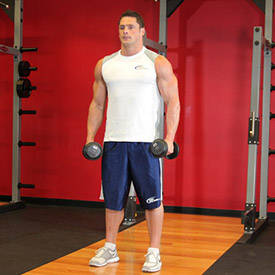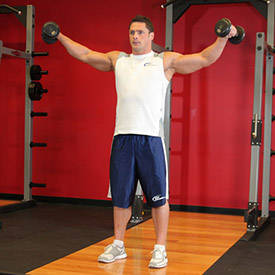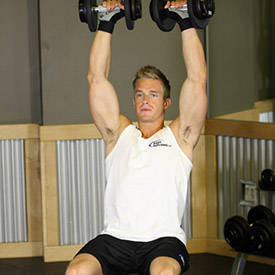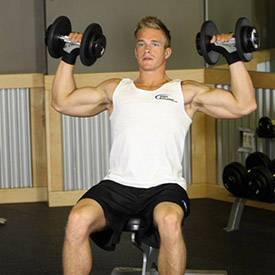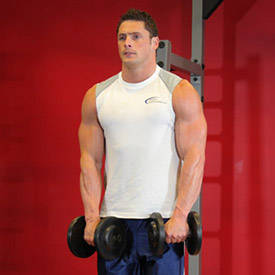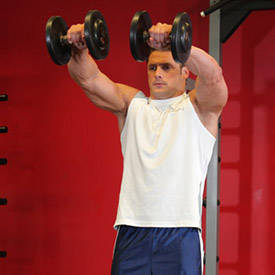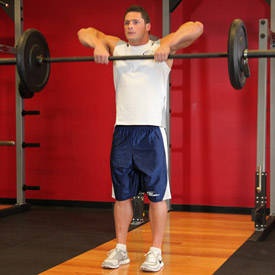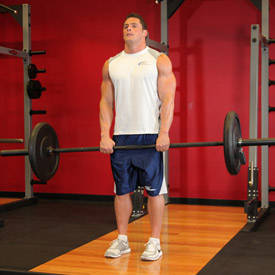Craig Capurso's Hi-Def Shoulder
Craig Capurso's Hi-Def Shoulder
Suffering
from sickly shoulders? We've got your cure. Start heavy but utilize
multiple speeds to work your delts for strength, size, and an incredible
muscle burn!
Many lifters approach shoulder day with the idea of pushing as much
weight as possible, as hard as possible, for as long as possible. This
may work in the short term, but after a while you'll become acquainted
with a hard-hitting member of the "itis" family, be it tendinitis,
bursitis, or one of their other inflammatory cousins.
While the allure of training at full throttle all the time may
appeal to your hardcore nature, IFBB physique pro and Cellucor-sponsored
athlete Craig Capurso has found a three-speed approach that's far more
effective—not just on shoulder day, but for his entire physique.
Craig's approach to building high-definition deltoids, which is
part of his personally designed Muscle Mash program, starts with power
moves, progresses to more focused exercises in which he locks in on the
mind-muscle connection, and finishes off with movements and speeds
designed to maximize the burn in the muscle.
Before diving into Craig's workout, heed his five key pieces of shoulder training advice.
Tune Your Training Split
It may seem unnecessary to start a shoulder-training article with a
word on your training split, but from Craig's perspective, it's
imperative.
"Shoulders are often used with other exercises when training chest
(front delts) and back (rear delts), so be careful how you structure
them in your training plan," he says. "Do too much and you may sideline
yourself for a week, but do too little and other muscles may begin to
overpower them."
What you don't want, he says, is to train upper body three days in a
row, so how you set up your split shouldn't be random. Further, Craig
recommends dialing down your volume and intensity a bit if you're
focusing on shoulders. "If you're going to specialize on bringing up
your delts, you may want to back off your chest intensity since your
delts are called into play on bench pressing exercises as well," he
says. Doing so will allow you to give more for each shoulder workout you
perform.

"If you're going to specialize on bringing up your delts, you may want
to back off your chest intensity since your delts are called into play
on bench pressing exercises as well."
Get Warmed Up
Shoulder injuries are one of the most common injuries that can take
a trainee out of the game for a few weeks or more, so you need to
protect those joints. "I start my shoulder workouts with some dynamic
warm-up sets that target the delts specifically, such as light lateral
raises, and some standing dumbbell presses before actually sitting down
to check my form and load the weight up for a major multi-joint
movement," Craig explains.
Doing warm-up sets shouldn't be confused with wasting your time.
Warming up is critical, especially the stronger you get. Not only will
you lower your risk of injury, but by the time you get to your heaviest
set, you'll be able to push more weight than you would've been
able to do otherwise. Just don't take your warm-ups anywhere close to
muscle failure, Capurso advises, or you'll compromise your strength on
your heavy working sets.
Prioritize the Big Lifts
When it comes to arranging his workouts, Craig's game plan is to
always start big. "I structure all my training around exercises that
engage the greatest degree of muscle mass," he says. With big compound
movements, any target muscle group can be pushed with heavy sets.
When training shoulders, the biggest move in the game is the
overhead press and its many variations. Whether done with a barbell or
dumbbells, overhead presses are the bread and butter of power shoulder
training.
"I always start off with a power movement that's
strength-oriented," says Craig, who opts for a clean and press as his
initial shoulder move in this workout.

Clean and Press
Connect Your Mind and Muscles
Craig correctly notes that many trainees oftentimes say they "don't
feel" heavy exercises, in part because they're just focused on moving
the load. His answer: Reduce the poundage toward the middle of your
workout, train more deliberately, and focus on connecting with the
target muscle.
"You'll feel the muscle to a greater extent when going lighter or
using a slower movement speed, because you can really amplify the
mind-muscle connection," says Craig.
Here's where Craig adds single-joint movements like front raises,
overhead shoulder flyes, and lateral raises. "I may not go as heavy on
these sets, so I'll usually increase the number of reps and really focus
on getting a squeeze with them," he says. By utilizing supersets and
slightly higher reps, Craig is able to work for enhanced muscle
definition.
Finish With a Bang
Craig's choice for a finishing move has a singular goal: to light a
fire and initiate a massive burn. "I like to finish my workouts with a
burnout set, and oftentimes it means doing slow movements or what I call
static holds (isometrics). The weight will be one in which I can really
hold and squeeze each rep," Capurso says.
In the workout below, Craig supersets a full minute of car drivers
with a 45-pound plate and barbell upright rows for 3 sets that sear in
an intense burn. He's also done lateral raises as a finisher, pausing at
the midpoint.

Upright Barbell Row
Here's Craig's three-part shoulder workout that builds size and definition, finishing with an intense muscle burn.
Craig Capurso's Hi-Def Shoulder Workout

1
Clean and press
4 sets of 8-10 reps
2
Side lateral raise
3 sets of 12 reps
3
Seated dumbbell press
4 sets of 8-10 repsSuperset
4
Seated overhead shoulder fly
3 sets of 1 minute nonstopBarbell front raise
3 sets of 10-12 repsSuperset
5
Car driver
3 sets of 1 minute nonstopUpright barbell row
3 sets of 10-12 reps
Notes
- On the first three exercises, take 2-3 minutes rest between sets.
- Don't rest after the first exercise in the superset pairing. Rest only after you complete both moves, and repeat for the designated number of sets.
- All exercises should be done using about 90 percent of your 9-rep max, or approximately your 10-12RM, with two exceptions: Use 25 percent of your body weight on overhead shoulder flyes, and 15 percent of your body weight on car drivers. Add or subtract weight on all subsequent sets as necessary.
- Craig performs rear-delt exercises on back day.



